lordroel
Administrator
Member is Online
Posts: 68,054 
Likes: 49,451
|
Post by lordroel on Oct 29, 2020 3:50:52 GMT
Day 457 of the Great War, October 29th 1915France: he tide has turned against Viviani- Since the vote of confidence in the Chamber of Deputies on the 12th, Prime Minister René Viviani has been attempting to reconstruct his cabinet to shore up political support. The tide has turned against Viviani, however, and many leading politicians refuse to join a government led by him. Abandoning the attempt, he accepts the position of Vice-President of the Council of Ministers (analogous to a Deputy Prime Minister) in a new government led by Aristide Briand. The minister of war, Alexandre Millerand, is also dismissed, replaced by General Joseph Gallieni, who had played an important part in the Entente victory at the Battle of the Marne. Serbian campaign: Austro-Hungarian VIII Corps makes little headway today against stiff Serbian resistance- North of Kragujevać, the Austro-Hungarian VIII Corps makes little headway today against stiff Serbian resistance, the latter supported by artillery fire. Seeing the inability of his western neighbour to make progress, General Lochow of the German III Corps believes that the two forces face extensive fixed fortifications, and orders his own corps to advance cautiously. To the west, the advance of the Austro-Hungarian XIX Corps and the German XXII Reserve Corps is slowed primarily by poor weather, slowing in particular the movement of artillery. The latter, after hard fighting yesterday, takes Gornji Milanovac today. On the other side of Kragujevać, the German IV Reserve Corps successfully attacks across the Lepenica River, taking 750 Serbian prisoners. Nevertheless, the corps is behind schedule - the attack had been originally scheduled for yesterday before swamped roads and high water had delayed the operation. Also today, patrols from the German X Reserve Corps make contact with elements of the Bulgarian 1st Army, thus linking up the two fronts under Mackensen's overall direction. Map: The Serbian campaign, Oct. 29th, 1915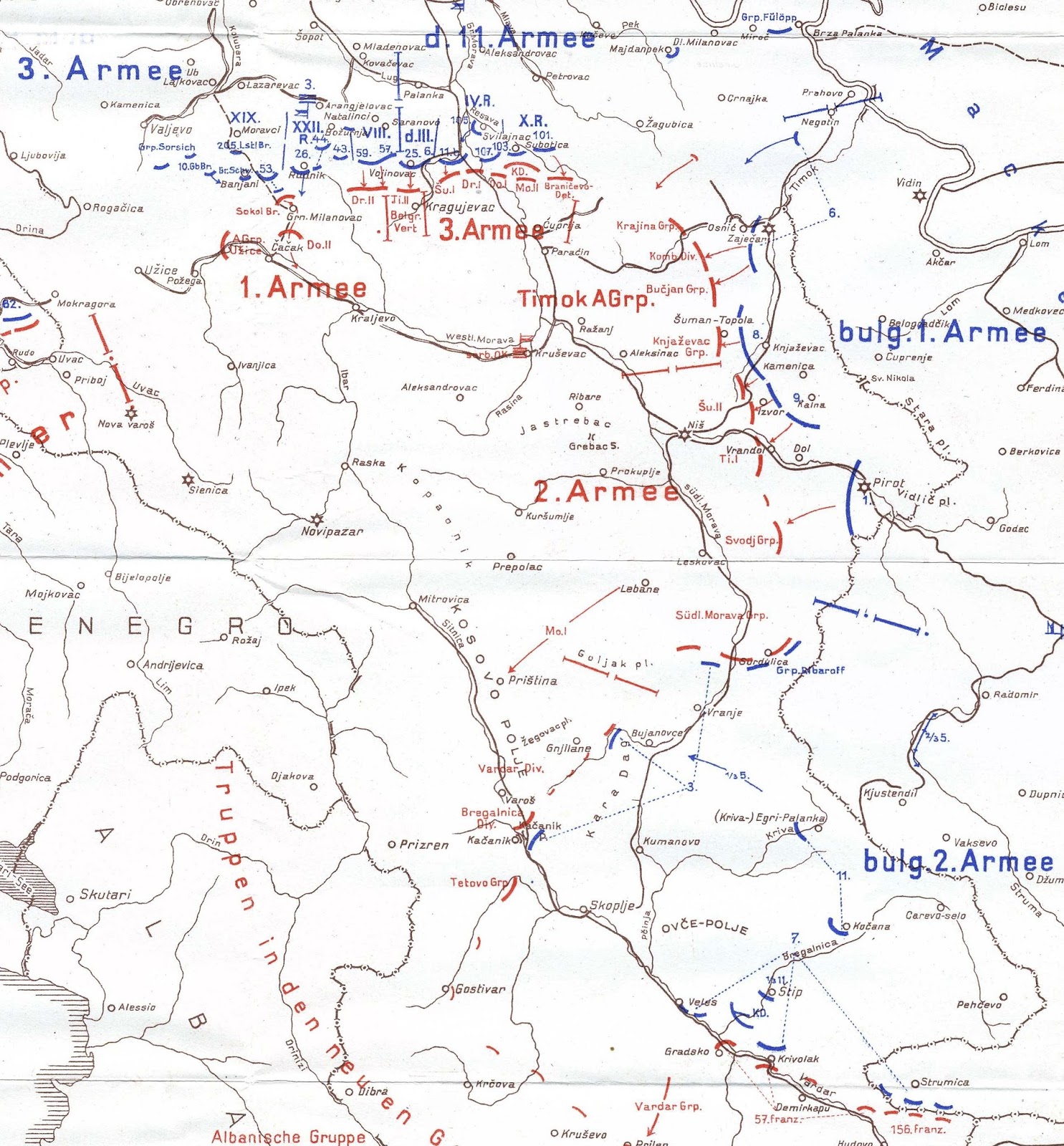 - Though yesterday's attacks around Görz on the Isonzo River failed to achieve any major breakthrough, Cadorna orders further energetic attacks today. After the exertions of the previous day, however, some of the Italian formations are simply incapable of similar assaults today - opposite Zagora, for instance, a counterattack by the Austro-Hungarian 1st Mountain Brigade throws back the Italian 3rd Division and takes two hundred prisoners, after which Italian activity in the sector noticeably declines. Opposite Görz only 11th and 12th Divisions of VI Corps attack today, which allows the defenders to concentrate their artillery fire on a narrower length of the front. Elements of the later again break into the Austro-Hungarian lines on the Podgora Heights, but in hand-to-hand combat lasting into the evening are unable to secure the position. Italian front: Third Battle of the IsonzoSouth of Görz, the Italian XIV Corps launches another effort to seize Mt. San Michele this morning. Elements of 30th Division manage to fight their way to the northern summit, but a well-timed counterattack by 39th Honved Brigade drives them off the high ground. To the south of Mt. San Michelle, 28th and 19th Divisions attempt to expand the ground seized yesterday; not only do they fail to do so, but after dark a counterattack by the Austro-Hungarian 17th Division regains the lost ground. North of Tolmein, after a night of bitter fighting, Austro-Hungarian reserves retake the trenches lost yesterday on the inner wings of 3rd and 14th Mountain Brigades. Further south, at noon the Italian VIII Corps attempts a crossing of the Isonzo River at Canale using boats and pontoons, but the engineers and their equipment make for obvious targets, and Austro-Hungarian artillery and machine-gun fire rapidly break up the attempt. Niedermayer–Hentig Expedition: the government of British India informs the Emir of Afghanistan that they will increase their subsidy as a sign of their continued friendshipIn light of the presence of the German mission in Kabul, the government of British India informs the Emir of Afghanistan that they will increase their subsidy as a sign of their continued friendship and to dissuade any thoughts of siding with the Germans. Emir Habibullah, however, continues to play the British and Germans off of each other, and decides to send no formal acknowledgement of the increased subsidy, lest the British conclude that his loyalty can be bought so cheaply.
|
|
lordroel
Administrator
Member is Online
Posts: 68,054 
Likes: 49,451
|
Post by lordroel on Oct 30, 2020 2:50:04 GMT
Day 458 of the Great War, October 30th 1915Serbian campaign: German reconnaissance discover that the formidable Serbian fortifications General Lochow had feared yesterday are nothing more than hastily dug trenches- Reconnaissance by elements of the German III Corps this morning discover that the formidable Serbian fortifications General Lochow had feared yesterday are nothing more than hastily dug trenches. Realizing the mistake, both the German III and the Austro-Hungarian VIII Corps are ordered forward, where they find the Serbian line manned only by rear guard formations which quickly fall back. The main Serbian forces retreated southward overnights, and though the two corps have gained ground they have failed in their primary objective of pinning the Serbian defenders at Kragujevać north of the city. Map: The German and Austro-Hungarian advance in Serbia, Oct. 30th to Nov. 22nd, 1915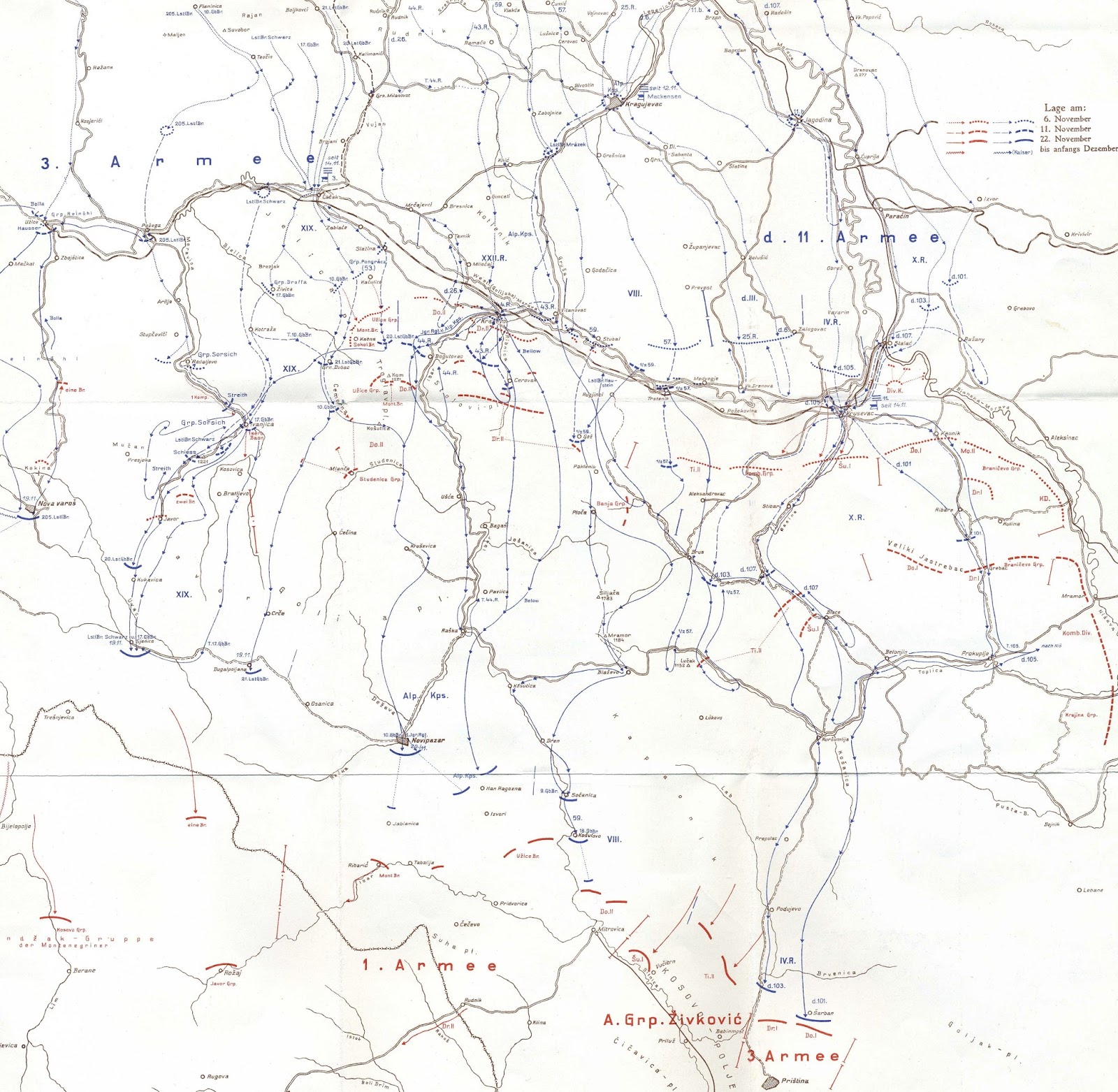 Italian front: Third Battle of the Isonzo Italian front: Third Battle of the IsonzoDue to the heavy losses sustained over the past two days at Görz, Cadorna realizes that large-scale operations cannot be undertaken for the third straight day; instead, small assaults are ordered on particular points while elsewhere artillery is left to do their work. Again the Podgora Heights just west of Görz are the scene of heavy fighting on the same pattern as before: several Italian battalions break into the Austro-Hungarian lines, but are unable to withstand enemy counterattacks. To the south, an Italian attack captures a small stretch of the enemy trench line at Peteano, and manage to hold the ground in the face of several Austro-Hungarian counterattacks.
|
|
lordroel
Administrator
Member is Online
Posts: 68,054 
Likes: 49,451
|
Post by lordroel on Oct 31, 2020 8:49:16 GMT
Day 459 of the Great War, October 31st 1915- It has become clear to General Putnik that the Austro-Hungarians and Germans intend to isolate and destroy his armies in central Serbia, and that significant aid from the British and French at Salonika cannot hope to arrive in time. His top priority is the preservation of the Serbian army as a fighting force, an objective that takes precedence even over holding Serbian territory. The strategic goals of the Serbian government have been reduced to stark simplicity: survival. Even if it was necessary to go into exile, an independent Serbian government and army needed to exist to keep alive the notion of a sovereign Serbian state. Putnik thus reluctantly orders his armies to abandon central Serbia - 1st Army is to withdraw through Kraljevo and 3rd Army through Paracin to Grebac, while 2nd Army would attempt to hold its position to cover 3rd Army before itself retreating. Overall, the Serbian army is to fall back to Kosovo in the southwest of the country, which also holds open the possibility of a further retreat west and southwest into Albania. The retreat, however, will have to occur in terrible weather conditions and over rough and mountainous terrain - for all of their losses over the past month, their suffering is only beginning. - Along the Isonzo River the Italian 2nd and 3rd Armies launch only small-scale attacks for the second day while keeping up a steady artillery bombardment. The Austro-Hungarians, though they have largely held their positions, have suffered heavy losses - several brigades report casualties of over a thousand in the past week of fighting, and overall losses exceed thirty-five thousand. The lull in the fighting (and the Austro-Hungarians recognize that it is merely a lull) allows for the relief of the most heavily-engaged formations; overnight 43rd Regiment of 20th Honved Brigade, which had held the summit of Mt. San Michele for nine days, is relieved and sent to a reserve camp to recover. For his part Cadorna hardly intends to abandon the offensive, as he still has several divisions in reserve to throw into the attack, and today he issues orders for a resumption of operations tomorrow. Naval operations: English ChannelHis Majesty's Yacht AIRIES, 258 tons; Norwegian freighter EIDSIVA, 1,092 tons, carrying a load of coal from Shields to Rouen; HM Trawler OTHELLO II, 206 tons; and British freighter SS TOWARD, 1,218 tons, bound from London to Belfast with a general cargo, all run onto a minefield laid by Matthias von Schmettow and UC-6. His score is now 17 ships and 14,222 tons. Naval operations: GallipoliBritish 'L' class destroyer HMS LOUIS is wrecked in Suvia Bay, then destroyed by Turkish coastal guns. Photo: HMS LOUIS stranded at Suvla, Gallipoli in 1915. The ship is under artillery fire from the Turks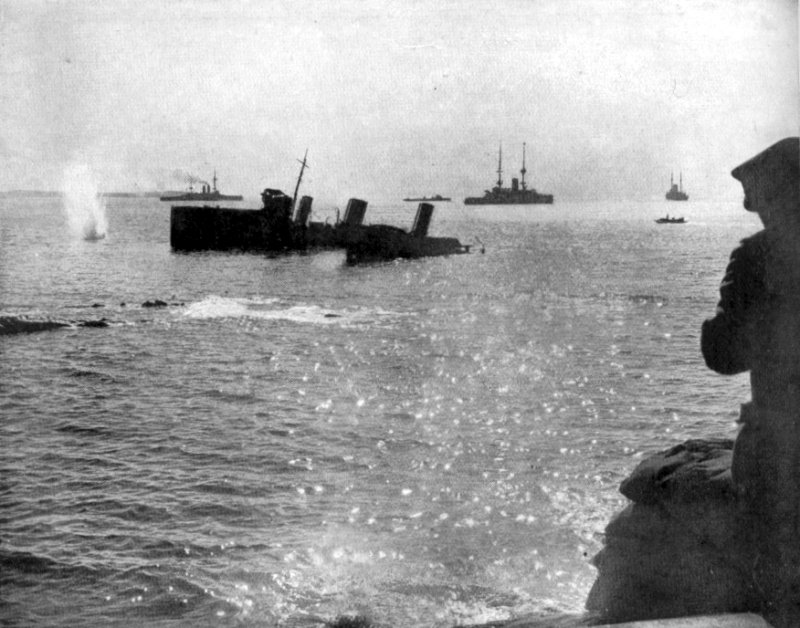 Naval operations: German East Africa Naval operations: German East AfricaBritish monitor HMS SEVERN probes the mouth of the Msala River, and fires 5 6" shrapnel shells at a German lookout platform.
|
|
lordroel
Administrator
Member is Online
Posts: 68,054 
Likes: 49,451
|
Post by lordroel on Nov 1, 2020 7:50:14 GMT
Day 460 of the Great War, November 1st 1915
Serbian Campaign: Serbian forces, after destroying the arsenal, have withdrawn south of the city
At Kragujevać Serbian forces, after destroying the arsenal, have withdrawn south of the city, and a municipal delegation arrives today at the headquarters of General Lochow of the German III Corps, offering the surrender of the city. Kragujevać is subsequently occupied by the German 168th Regiment of 25th Reserve Division, supported by elements of the Austro-Hungarian 57th Division. Because the railway connection had been severed, the Serbians were forced to leave behind large amounts of war material, as well as 2100 wounded soldiers.
The victory, however, is at best partial, as Mackensen's two armies have failed to envelop the Serbian 1st and 3rd Armies before them. The failure of the German III and Austro-Hungarian VIII Corps to pin the Serbs north of the city allowed them to withdraw to the south, while the western flank of the Austro-Hungarian 3rd Army has been slowed by poor weather - while the Austro-Hungarian XIX Corps today reaches the West Morava River at Čačak, while the German XXII Reserve Corps has yet to reach the Čačak-Kragujevać road. Instead of the army's western flank pushing ahead of the corps opposite Kragujevać, they are still in line with them. Mackensen and Seeckt, however, still hoping to destroy the Serbian armies in the field, orders their increasingly exhausted forces forward - the Austro-Hungarian 3rd Army is to push south to Kraljevo while the German 11th Army is to capture the confluence of the Morava and West Morava Rivers.
Greece: chief of the Greek General Staff, General Victor Dousmanis, and the assistant chief, Colonel Ioannis Metaxas, are staunchly monarchist, and side with King Constantine's policy
The chief of the Greek General Staff, General Victor Dousmanis, and the assistant chief, Colonel Ioannis Metaxas, are staunchly monarchist, and side with King Constantine's policy of neutrality as opposed to the dismissed Venizelos' pro-Entente stance. Given the substantial Entente presence at Salonika, the possibility exists that circumstances may draw Greece into the war on the side of Germany - for example, if the French forces in southern Serbia cross back into Greece, the latter, as a neutral, by international law ought to disarm them, but the Greek General Staff is under no illusions what would follow such an act. With Constantine's blessing, the pair, while emphasizing that continued neutrality is their preferred policy, approach the German military attaché in Athens regarding the extent and nature of German support in the event of war. Metaxas is particularly concerned about naval support - with its long coastline and many islands it is particularly vulnerable to British seapower, while sea transport, especially of food from southern Greece to northern, is essential to Greek survival. Metaxas inquires of the German military attaché whether German submarines would be able to protect coastal trade and limit Entente access to the Aegean Sea. He also requests, in the event of war, artillery batteries and munitions for coastal defence.
Italian front: Third Battle of the Isonzo
After a two-day lull, the Isonzo front from Plava in the north to Mt. dei sei Busi in the south is again the scene of heavy fighting as Italian infantry again fling themselves against the Austro-Hungarian defences. At Zagora the Italians launch a attack at dawn without a preliminary bombardment and under cover of rain and fog which catches the Austro-Hungarians by surprise; the Italians take the enemy position and capture many prisoners. This evening two Austro-Hungarian battalions counterattack, forcing the Italians to abandon part of the thoroughly-ruined village.
Opposite Görz itself, after a heavy bombardment Italian infantry advance at 7am. A brigade of 10th Division attempts to seize the summit of Mt. Sabotino, but is repulsed by the Austro-Hungarian 60th Brigade. To the south, the inner wings of 11th and 12th Divisions make initial headway on the Podgora and Hill 184, but the rapid deployment of Austro-Hungarian reserves allows for most of the lost trenches to be regained this evening.
To the south, the Italian 3rd Army has received 22nd Division from reserves, and heavy attacks are launched from north of Mt. San Michelle to Mt. dei sei Busi. South of St. Martino, regiments from 28th and 19th Divisions break into the Austro-Hungarian trenches, but counterattacks force them to relinquish most of the ground gained. Elsewhere, the attacks of 3rd Army accomplish nothing.
|
|
lordroel
Administrator
Member is Online
Posts: 68,054 
Likes: 49,451
|
Post by lordroel on Nov 2, 2020 3:52:32 GMT
Day 461 of the Great War, November 2nd 1915
Italian front: Third Battle of the Isonzo
South of Plava, just after dark a counterattack by the Austro-Hungarian 18th Division retakes another portion of the ground at Zagora lost yesterday morning. To the south, heavy Italian attacks once again are directed to the heights at Podgora just west of Görz, and after several attempts Italian infantry reach the first Austro-Hungarian trench line, rendered unrecognizable by artillery fire. Into the evening, Italian and Austro-Hungarian infantry engage in desperate combat in the ruined landscape between what once was the first and second trench lines. After dark, an Austro-Hungarian counterattack by two battalions rushed forward from the divisional reserve manages to regain much of the lost ground. The 11th Italian Division, meanwhile, is able to push into Oslavija, seizing the enemy trenches anchored by the village church. On 3rd Army's portion of the line, heavy artillery fire begins at 7am and continues into the late afternoon, after which infantry attacks break to the positions of the Austro-Hungarian 17th Division in three places south of St. Martino. General Elder von Gelb, the divisional commander, assembles the last available reserves - the remnants of 33rd and 111st Landsturm Brigades - and prevent further Italian advances here. On either flank, Italian assaults were unable to make any headway.
United Kingdom: Prime Minister Asquith praises the British advance in Mesopotamia
Speaking in the House of Commons, Prime Minister Asquith praises the British advance in Mesopotamia by stating that 'I do not think that in the whole war there has been a series of operations more carefully contrived, more brilliantly conducted, and with a better prospect of final success.' However true this may have been of the campaign to date, the reality is that it is about to go badly off the rails.
East African campaign: Colonel Paul von Lettow-Vorbeck, commander of German forces in the colony of German East Africa, receives a message from Berlin
Colonel Paul von Lettow-Vorbeck, commander of German forces in the colony of German East Africa, receives a message from Berlin, originally dispatched in May, reporting revolution in Sudan. Given the British commitment to Europe and the likelihood of defeat at Gallipoli, this information reinforces Lettow-Vorbeck's belief that the forces under his command are at least the equal of those in British East Africa to the north. As such, planning begins for a major offensive aimed at Mombasa. Lettow-Vorbeck's objective at this stage of the war is not simply survival, but victory, to crush enemy forces in British East Africa in a decisive battle.
|
|
lordroel
Administrator
Member is Online
Posts: 68,054 
Likes: 49,451
|
Post by lordroel on Nov 3, 2020 3:52:31 GMT
Day 462 of the Great War, November 3rd 1915
United Kingdom: Prime Minister Aristide Briand addresses the Chamber of Deputies
Prime Minister Aristide Briand addresses the Chamber of Deputies today for the first time since the appointment of his government on the 29th, during which he pledges not to abandon Serbia. This promise, however, is particularly ill-timed, given that at this very moment the Serbian army is itself abandoning Serbia, falling back to the southwest while the French Army of the Near East has been unable to either break through the Bulgarian 2nd Army to relieve the Serbs or distract the enemy to allow the Serbs time to rest and regroup.
Macedonian front: General Sarrail now feels that he has sufficient forces to go on the attack
At Salonika, the third French division - 122nd - began landing on the 1st, and with its first brigade now available for servicee General Sarrail now feels that he has sufficient forces to go on the attack. North of Krivolak, Bulgarian forces have crossed the Vardar River and are advancing southwest with the Tcherna River on their left. Sarrail orders the French 57th Division along with the first brigade of 122nd Division to cross the Tcherna and hit the Bulgarians in their flank. To the southeast, however, Bulgarian forces launch heavy attacks on French forces at the Strumica rail station.
Italian front: Third Battle of the Isonzo
- Along the Isonzo River the Italian II Corps launches eight separate attacks at Plava from noon until dark. The Austro-Hungarian defenders suffer heavy losses - the four most heavily engaged battalions have lost up to 40% of their strenght - but several reserve battalions are brought forward to hold the line. As a result, the Italians are unable to break through.
At Görz, the Austro-Hungarian 37th Landsturm Brigade, the last available reserve, counterattacks the Italian 11th Division at Oslavija this evening and drives the enemy back out of the village, regaining the trenches lost yesterday and capturing several hundred prisoners. A further series of assaults are launched by the Italians against the heights at Podgora, and after several attempts elements of 12th Division gain the summit of Heights 184. By this point, fighting here had devolved into small-unit fighting, with hardly any higher commanders able to influence the course of events, and infantry fought over shell holes filled with up to a metre of mud into the night.
South of Görz, the Austro-Hungarian 39th Brigade on the northern slope of Mt. San Michele is relieved overnight by three battalions from 6th Division. During the transfer, however, one of the battalions became separated from its guides, and unfamiliar with the ground stumbled past the position it was to occupy and walked right into the Italian line. Taking fire from three sides, the battalion takes severe losses before extricating itself. As a result, the Austro-Hungarians are forced to evacuate a small stretch of their own line due to the soldiers who would have guarded having been killed on the Italian line. Still, the Austro-Hungarians are able to form a new defensive line a mere fifty yards to the rear, and Italian attacks against this new position today fail to make any progress. A general Italian assault by VII Corps north and south of St. Martino also fails completely.
Aerial operations: RFC is a gentleman club
At the outbreak of war, the British Royal Flying Corps had been a small unit whose pilots were drawn from the upper classes. To date applications to join the RFC have outpaced positions, allowing it to be selective in who it admits, with the result that the RFC have continued to draw from the same social classes as before the war. There is a strong and ingrained belief among the pilots of the RFC that 'gentlemen' officers, graduates of prestigious public schools and Oxbridge, make the pilots. Given this makeup, it is not surprising that British pilots at this stage of the war approach it as a sport and a grand adventure in the skies, one that stands in sharp contrast to the masses in the mud below. Character and background count for more than skill, and thus when the The Aeroplane magazine suggests today that pilots should enter the RFC as noncommissioned officers and be promoted on the basis of merit, the notion is rejected out of hand. To the current pilots of the RFC, its social exclusivity is not accidental but rather a deliberate approach to recruitment designed to ensure that future pilots meet the 'proper' standards - social as much as anything else - to be an officer of the RFC.
Naval operations: North Sea
British freighter SS FAIRGATE, 264 tons, carrying a cargo of loam from London to Middlesbrough, hits a mine laid by Matthias von Schmettow and UC-6, bringing his score to 18 ships and 14,486 tons.
British iron trawler FV DOMINICAN, 134 tons, goes missing while on a fishing trip out of Grimsby. No trace has ever been found.
Naval operations: Mediterranean Sea
Waldemar Kophamel, commanding U-35, sinks British freighter SS WOOLWICH, 2,936 tons, bound from Port Sudan to Plymouth with a load of phosphates and zinc. Kophamel's score is now 25 ships and 51,221 tons.
Max Valentiner, in U-38, sinks British freighter SS WOOLDFIELD, 3,584 tons, travelling in ballast from an unlisted port to Salonica; and Japanese freighter YASUKUNI MARU, 5,118 tons, carrying petroleum products and railway materiel from Newport News to Salonica, both north of Morocco just inside the Strait of Gibraltar. Valentiner's score is now 55 ships and 89,284 tons.
|
|
lordroel
Administrator
Member is Online
Posts: 68,054 
Likes: 49,451
|
Post by lordroel on Nov 4, 2020 3:37:17 GMT
Day 463 of the Great War, November 4th 1915Macedonian front: General Paul Leblois, commander of the French 57th Division, submits a pessimistic report to General SarrailGeneral Paul Leblois, commander of the French 57th Division, submits a pessimistic report to General Sarrail regarding the prospects of the offensive he has ordered in southern Serbia. Leblois argues that there are insufficient forces to hold the confluence of the Tcherna and Vardar Rivers while his division pushes across the Tcherna to the southwest. He fears that without significant reinforcements, his lines of communications will be vulnerable. Moreover, he describes the region as without roads or water, making resupply difficult. Italian front: Third Battle of the Isonzo- This morning Austro-Hungarian survivors on the heights at Podgora slowly but surely push back the Italian infantry who had seized the summit of Heights #184 yesterday, and by noon the Italians continued to hold only a small stretch of trench on the western slope. To the south, Italian attacks at Mt. San Michele and St. Martino are repulsed in heavy fighting. This evening Cadorna calls a halt to the 3rd Battle of the Isonzo, citing exhaustion, the need to replace losses, and poor weather. In the course of the fighting, no ground of any consequence has been gained - for example, though the Italians have been able to push their lines forward towards the Podgora heights, the high ground remains firmly in the control of the Austro-Hungarians. The broader objectives of the offensive, including the city of Görz, remain as beyond the reac of the Italians as they had been at the start of the offensive. Accomplishing these meagre gains has cost the Italian army 67 000 casualties, constituting 23% of the attacking, and some of the regiments involved in the heaviest fighting have lost over half their strength in the two weeks of the operation. The Austro-Hungarians, however, have suffered heavily as well - total losses have numbered 42 000, which includes 23 000 casualties for VII Corps, responsible for the line from north of Mt. San Michele to Mt. dei sei Busi. Though the 3rd Battle of the Isonzo is at an end, Cadorna is far from finished. Indeed, in the order this evening cancelling the offensive the Italian chief of staff called on his armies to be prepared to immediately go onto the offensive. With Austro-Hungarian armies committed to the Russian front and engaged on the Serbian front, he feels that they have little to no reserves available to meet another thrust along the Isonzo. Further, the Italian parliament is scheduled to resume sitting on December 1st, and both Cadorna and the government are eager to have some tangible success to lay before them to head off criticism of the management of the war. It is to be a short respite indeed for both the Italian and Austro-Hungarian soldiers along the Isonzo. Naval operations: North SeaGerman submarine SM UC-8 runs aground near Terschelling, Netherlands, and is interned by the Dutch. Photo: Former German submarine UC-8 in Dutch service as M 1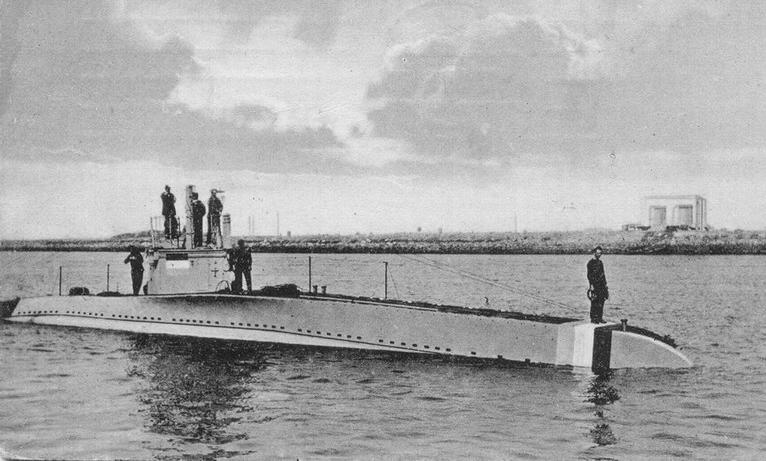 Naval operations: Mediterranean Sea Naval operations: Mediterranean SeaMax Valentiner, commanding U-38, sinks French freighters SS DAHRA, 2,127 tons, following an unknown route with a cargo of grain; and SS LE CALVADOS, 1,658 tons, bound from Marseille to Oran carrying troops and war materiel; Italian freighter SS IONIO, 1,816 tons, carrying a general cargo; and damages British freighter SS MERCIAN, 6,305 tons; all in the area north of Oran, Algeria. His score is now 58 ships and 94,885 tons. U35 - arrives at the Senussi-controlled port of Bardia in Italian Libya, just across the border from British Egypt, where it delivers ten Ottoman officers, 120 soldiers, and munitions to support the Senussi uprising against the Italians. With Entente naval supremacy in the Mediterranean, transport by submarine is the only way for Germany and its allies to provide aid to the Senussi in North Africa. Such voyages, however, mean overcrowded submarines that are hardly spacious to begin with; Capital Waldemar Kophamel is happy to offload his cargo and depart Bardia.
|
|
lordroel
Administrator
Member is Online
Posts: 68,054 
Likes: 49,451
|
Post by lordroel on Nov 5, 2020 3:48:42 GMT
Day 464 of the Great War, November 5th 1915YouTube (The Third Battle of the Isonzo - French Despair On The Western Front)Macedonian front:Bulgarian forces occupy the de facto Serbian capital of Niš- As the Serbs pull back to the southwest, Bulgarian forces occupy the de facto Serbian capital of Niš today. - At Salonika the second British division committed to the expedition beings to unload. - In Greece the government of Alexandros Zaimas, appointed by Constantine a month ago when the monarch split with the pro-Entente former Prime Minister Eleutherios Venizelos, has been unable to securing a working majority in the Greek parliament, dominated as it is with supporters of Venizelos. As a result, Zaimas' government tenders its resignation today, and while a new government of 'national unity' (though excluding Venizelos' supporters) under Stephanos Skouloudis is appointed, Constantine also dissolves parliament for new elections. Naval operations: Sea of MarmaraOn October 30th, the French submarine TURQOISE, the first to operate in the Sea of Marmara, had run aground and captured intact. Admiral Souchon had been shocked by the state of TURQOISE, and writes to his wife today 'how the French commander could come into the Marmara in the defective boat is incomprehensible.' However, aboard the French submarine the Germans had discovered papers that referred to a planned rendezvous today with the British submarine E20. This allowed the German submarine UB14 to set a trap, and when E20 arrives for the supposed rendezvous it is instead torpedoed and sunk. Photo: A French postcard of TURQOISEon the surface, 3 April 1913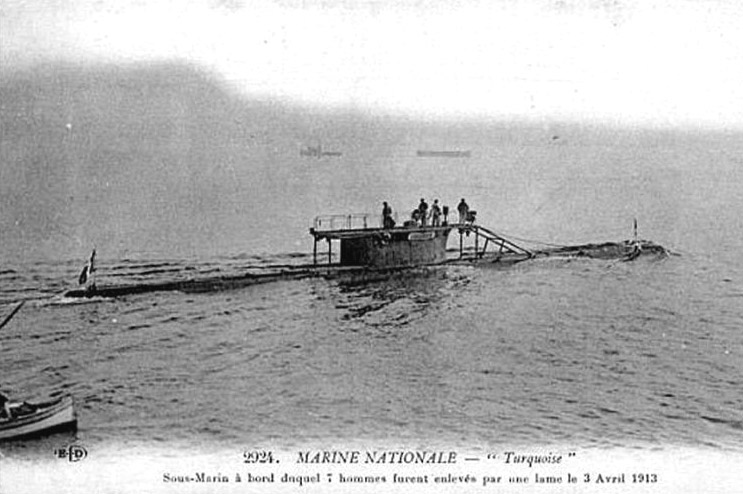 Naval operations: Mediterranean Sea Naval operations: Mediterranean SeaWaldemar Kophamel, commanding U-35, sinks British armed boarding steamer HMS TARA, 1,862 tons, and Egyptian coast guard vessel ABBAS, 298 tons. Kophamel puts the survivors into lifeboats with some on the deck of the u-boat, and tows them to the port of Suliman, where they are made prisoner by Libyan officials. Later they will be handed over to the local Senoussi tribe. Kophamel attacks another Egyptian coast-guard boat, NOUR-EL-BAHR, but she is only damaged. His score is now 27 ships and 53,381 tons. Max Valentiner, in U-38, sinks British freighter SS BURESK, 3,673 tons, traveling in ballast from Malta to Barry, and French freighter SS SIDI FERRUCH, 2,797 tons cargo and route unlisted. Valentiver becomes the second u-boat captain to pass the hundred thousand mark with 60 ships and 101,355 tons. Naval operations: Baltic SeaJohannes Spieß, commanding U-9, torpedoes Russian auxiliary minesweeper DAGO. His score is now 13 ships and 9,715 tons. This is U-9's last sinking. Spieß will go on to command U-19.
|
|
lordroel
Administrator
Member is Online
Posts: 68,054 
Likes: 49,451
|
Post by lordroel on Nov 6, 2020 8:36:36 GMT
Day 465 of the Great War, November 6th 1915Serbian Campaign: Falkenhayn and Conrad meet at Pless- Falkenhayn and Conrad meet at Pless today to discuss the campaign in Serbia. From the perspective of the German chief of Staff, the capture of Kragujevać and Niš, combined with the defeat of the Serbian army, accomplished the overall objective of the offensive of opening a land route to the Ottoman Empire. As such, Falkenhayn wishes to wind down operations in the Balkans, shifting forces from this theatre to the Western Front. Conrad, as usual, has a different opinion: he feels the Entente landing at Salonika needs to be eliminated, and also favours continuing operations to finish off the remnants of the Serbian army and deal with Montenegro. After a full day of discussion, with the usual acrimony between the two chiefs of staff, it is agreed to continue the campaign for the time being, but that German forces would be withdraw as desired by Falkenhayn. In particular, as the pursuit of the Serbs entered the mountains, the German chief of staff wants to withdraw those German divisions not suited to warfare in such conditions. In practice this means a drawdown of Mackensen's forces to four or five divisions, including the German Alpine Corps, which reaches Kragujevać en route to the front. Further, Serbia was to be occupied by Austria-Hungary and Bulgaria, with the Morava River separating the two zones of occupation. Finally, the fate of Montenegro and Albania is deferred to a later date. Mackensen, for his part, still hopes to trap the bulk of the Serbian army. To accomplish this he issues orders today for Gallwitz's 11th Army to advance on Kruševac while the Bulgarian 1st Army pushes west from Niš. The key role would be played by the Austro-Hungarian VIII and the German XXII Reserve Corps of the Austro-Hungarian 3rd Army, with the former crossing the West Morava River and marching to Brus, and the latter seizing Kraljevo at the confluence of the West Morava and Ibar Rivers. If this succeeds, they will cut the line of retreat of the Serbian army falling back from the northeast. The next phase of the offensive gets off to a good start when the German 43rd Reserve Division of XXII Reserve Corps assaults Kraljevo today. Crucially, 202nd Reserve Regiment manages to capture the bridge over the West Morava River at the northern edge of Kraljevo before the Serbs can completely destroy it. Using wooden planks, they are able to patch up the bridge, allowing 201st Reserve Regiment to cross and fight into the city itself. When the railway station is captured, the municipal government surrenders the city. Again, because of the disruption of the Serbian rail network, the Germans capture trains loaded with artillery pieces and munitions that had nowhere to go. The seizure of the city also puts the German forces at the northern end of the Ibar River valley, a key retreat route for the Serbian army. Photo: German soldiers marching through the Serbian town of Paracin, November 1915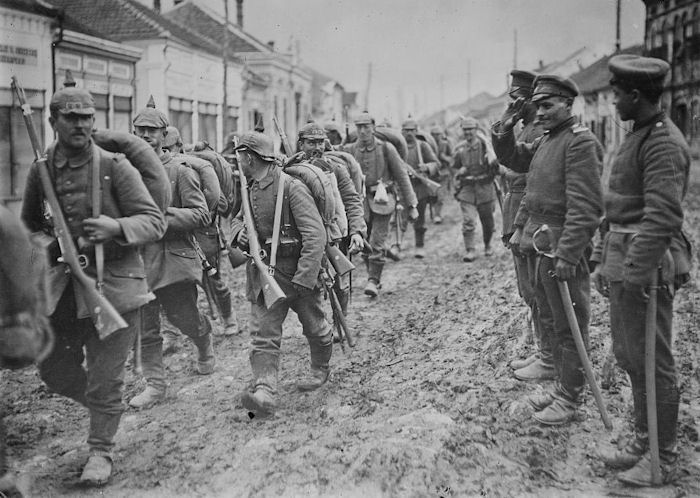 Naval operations: Gulf of Bothnia Naval operations: Gulf of BothniaFritz Stuhr, in U-10, sinks Finnish freighter SS BIGRIT, 226 tons, carrying a general cargo from from Stockholm to Matyluotu. His score is now 7 ships and 1,651 tons. Naval operations: Mediterranean SeaWaldemar Kophamel, in U-35, sinks British freighters SS CARIA, 3,032 tons, travelling in ballast from Liverpool to Alexandria; CLAN MACALISTER, 4,835 tons, bound from Liverpool to Calcutta with a general cargo; and tanker LUMINA, 6,218 tons, carrying fuel oil from Tarakan to Malta. His score is now 30 ships and 57,466 tons. Max Valentiner, Commanding U-38, sinks Italian sailing brigantine ELISA FRANCESCA, 208 tons; British freighter GLENMOOR, 3,075 tons, bound from Bombay to Tees carrying manganese ore; TICINO, 1,470 tons, route and cargo unlisted; and French freighter YSER, 3,545 tons, hauling a general cargo from Cardiff to Bizerta. His score is now 64 ships and 109,595 tons French freighter SS EMILE, 966 tons, goes missing. Naval operations: Sea of MarmaraHeino von Heimburg, in UB-14, sinks British submarine E-20, 725 tons, bringing his score to 5 ships and 24,298 tons. Photo: HMS E20 in harbour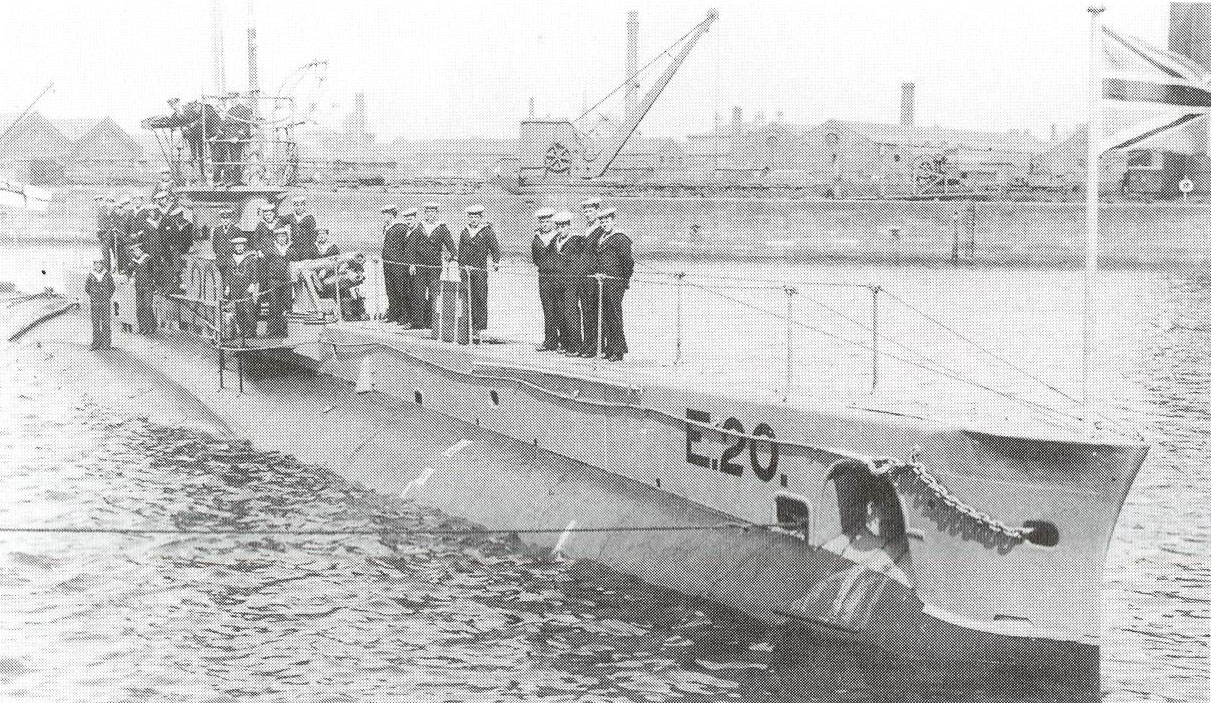
|
|
lordroel
Administrator
Member is Online
Posts: 68,054 
Likes: 49,451
|
Post by lordroel on Nov 7, 2020 7:45:41 GMT
Day 466 of the Great War, November 7th 1915Serbian Campaign: Elements of the German IV Reserve and X Reserve Corps seize the Serbian city of KruševaElements of the German IV Reserve and X Reserve Corps seize the Serbian city of Kruševac. Over the past two days, the Germans have captured six to seven thousand prisoners, as well as fifty locomotives and 1100 loaded railcars immobilized by the collapse of the Serbian rail network. Naval operations: Mediterranean SeaWaldemar Kophamel, commanding U-35, sinks British freighter SS MOORINA, 4,994 tons, bound from Bombay to Marseille with an unlisted cargo. His score is now 31 ships and 62,460 tons. Three days after sinking the French transport CALVADOS, the German submarine U38 strikes again today, and ignites a diplomatic firestorm. Off Bizerte it intercepts the Italian passenger liner ANCONA en route from Messina to New York. Initially the liner attempts to escape, but shelling from U38 brings it to a halt. The captain of U38 gives the crew and passengers of Ancona forty-five minutes to abandon ship, but when he sees smokes on the horizon he decides that ANCONA may have summoned a warship to its rescue, and orders a torpedo fired into the liner. Quickly sinking, over two hundred passengers are lost, several of whom are Americans. Photo: liner ANCONA The loss of American life by itself is contentious, given the crises provoked by the sinking of Lusitania and Arabic in earlier this year. Further complicating matters is that U38 flew the Austro-Hungarian while surfaced, standard practice for German submarines when attacking Italian-flagged ships, given that Germany and Italy are not at war. This means, of course, that diplomatic protests by the Americans over the sinking of Ancona are directed at Austria-Hungary, not Germany, and the navies of the two allies have to ensure they have their stories straight to appease the Americans. Newspaper: Front page of the The Evening World. November 10, 1915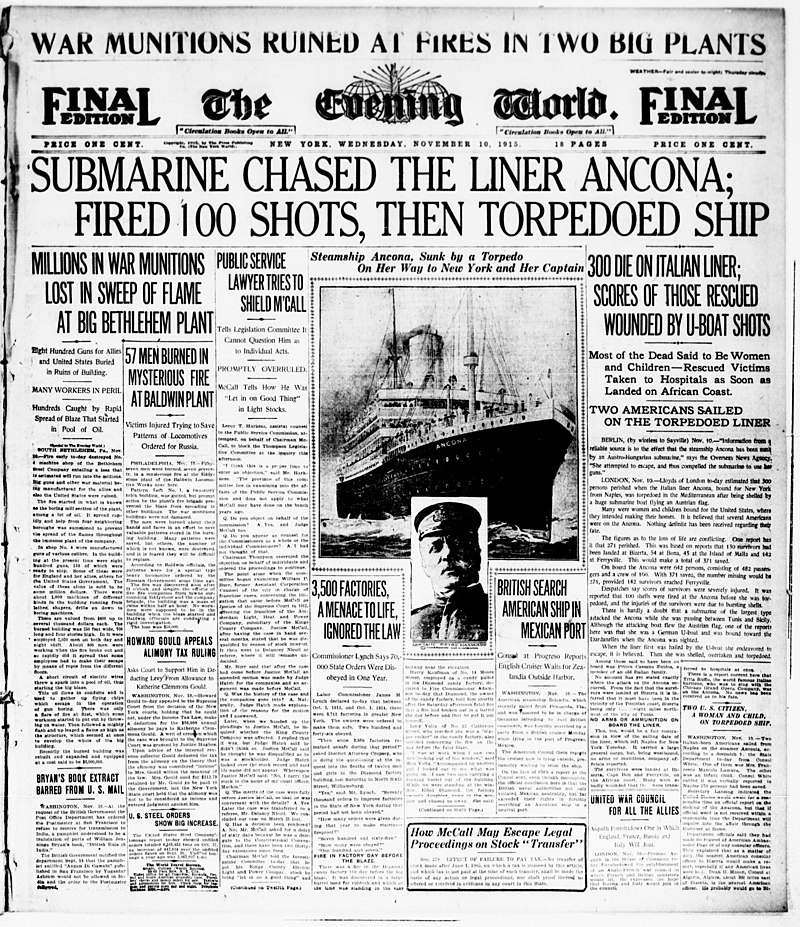 Naval operations: Cape Arkona Naval operations: Cape ArkonaGerman cruiser UNDINE is attacked by the British submarine E19, under the command of Lieutenant Commander Francis Cromie. E19 launched a pair of torpedoes at UNDINE at a range of 1,000 m, both of which hit. The second torpedo detonated her ammunition magazines and blew up the ship. Photo: The German light cruiser UNDINE underway
|
|
lordroel
Administrator
Member is Online
Posts: 68,054 
Likes: 49,451
|
Post by lordroel on Nov 8, 2020 7:45:37 GMT
Day 467 of the Great War, November 8th 1915
Serbian Campaign: German 11th Army front is narrowed considerably
As the German 11th Army had converged on Kruševac, its front had narrowed considerably, while the few roads in the region limited the amount of men and material that could be moved forward. Moreover, with the mountains approaching it was time, as per the discussions at Pless on the 6th, to take out of the line those German formations not equipped for mountain warfare. As a result, from the German 11th Army the German III Corps, along with 25th Reserve and Bavarian 11th Divisions and the headquarters of IV Reserve Corps, are ordered north out of Serbia today. Further, the German 26th Division in the Austro-Hungarian 3rd Army receives similar orders, though this formation is to be replaced by the German Alpine Corps.
German/Greece relations
After discussion between senior German army and navy officials in Berlin, the German naval attaché in Athens presents the German reply to the questions posed last week by General Dousmanis and Colonel Metaxas of the Greek General Staff. While German submarines already doing what they could to interrupt Entente supply lines to their forces at Salonika, there was nothing more they could realistically accomplish - the number available in the Mediterranean were insufficient to close off the Aegean Sea entirely, and using them defensively to protect the Greek coast would greatly limit their effectiveness by keeping them in port. Moreover, there was no particular need for Greek port facilities, given that German submarines had the range to operate from Austro-Hungarian and Ottoman bases. Indeed, the best assistance the Greeks could offer at sea would be intelligence regarding Entente ship movements. On land, the Germans noted that only limited munitions or artillery pieces could be provided, given that there were already commitments to the Ottoman Empire and Bulgaria that remained to be fulfilled. Overall, Greek entry into the war on Germany's side would provide few benefits and greater drawbacks; indeed, at this stage of the war Greek neutrality was more useful from the German perspective than actual intervention. If nothing else, the German reply offers nothing on which either King Constantine or the Greek General Staff can justify going to war against the Entente.
Naval operations: Mediterranean Sea
Waldemar Kophamel, commanding U-35, sinks British freighters SS DEN OF CROMBIE, 4,949 tons, bound from Bangkok to Lisbon and Oporto with a general cargo; SIR RICHARD AWDRY, carrying rice from Saigon to Marseille; and Norwegian freighter SS WACOUSTA, headed from Pictou, Nova Scotia to Vladivostok with a load of railway materials. His score is now 34 ships and 73,164 tons.
|
|
lordroel
Administrator
Member is Online
Posts: 68,054 
Likes: 49,451
|
Post by lordroel on Nov 9, 2020 3:42:04 GMT
Day 468 of the Great War, November 9th 1915
Serbian Campaign: Serbian army once more slipped the noose.
Though the seizure of Kraljevo on the 6th had raised hopes that the Serbian army could be enveloped, once more they have slipped the noose. This time, blame can be apportioned between the Bulgarians and Austro-Hungarians - the Bulgarian 1st Army had advanced slowly west from Niš, allowing the Serbs before them to disengage and retreat to the southwest, while General Kövess had permitted most of his army two days of rest after the fall of Kraljevo. The result is a blistering telegram from Mackensen to Kövess, asking how he had misunderstood the necessity for haste.
Naval operations: North Sea
British lighthouse tender IRENE, 543 tons, hits a mine laid by Econ von Werner and UC-1, with 21 casualties. Von Werner's score is now 8 ships and 8,162 tons.
British destroyer HMS MATCHLESS, 1,010 tons, is damaged by a mine.
Russian schooner SV POLAR, 200 tons, travelling from Arkhangelsk to Yarmouth, is lost and drifts ashore at Portmahomack, Scotland.
Swedish freighter SS SKANDIA, 4,336 tons, is lost after colliding with Norwegian SS Freikoll.
Norwegian freighter SS KRAASTAD, 1,390 tons, departs Port Talbot for Bordeaux with a load of coal and is not heard from again. Her crew of 18 are all lost.
Naval operations: English Channel
Ralph Wenninger, in UB-17, mistakes French fishing vessel JESUS MARIA, 74 tons, for a destroyer in the darkness and torpedoes the small craft. The crew of 6 are all lost. Wenninger's score is now 7 vessels and 539 tons.
Naval operations: Mediterranean Sea
Waldemar Kophamel, commanding U-35, finishes his seventh war patrol with the sinking of British freighter SS CALIFORNIAN, 6,223 tons, travelling in ballast from Salonica to Marseille. His score is now 34 ships and 75,866 tons.
Max Valentiner, in U-38, sinks Italian freighter SS FIRENZE, 3,960 tons, bound from Genoa to Port Said with a general cargo. His score is now 67 ships and 125,790 tons.
|
|
lordroel
Administrator
Member is Online
Posts: 68,054 
Likes: 49,451
|
Post by lordroel on Nov 10, 2020 3:50:06 GMT
Day 469 of the Great War, November 10th 1915Serbian campaign: Serbian army has not lost all fighting spirit- As battered as the Serbian army is, it still has not lost all fighting spirit. Today the Timok 1st, Sumidija 2nd, and Morava 2nd Divisions of the Serbian 2nd Army launch a counterattack against the Bulgarian 1st Division, forcing it back toward Leskovac. This gives 2nd Army breathing room to resume its retreat. - Though Cadorna had suspended the offensive of the Italian 2nd and 3rd Armies along the Isonzo River on the 4th, over the past five days Italian artillery has kept up a steady rate of fire on Austro-Hungarian lines, and there have been a number of small-scale attacks against specific points. Though these actions were designed to give the enemy no rest and no chance to rebuild defences and bring up replacements, they also clearly signaled to Austria-Hungary that further operations were forthcoming, an impression enhanced both by intelligence reports indicating trains were bringing Italian replacements and supplies to the Isonzo front, and by the noise of wagons and motor vehicles behind the Italian line. Thus the opening attacks of the 4th Battle of the Isonzo today comes as no surprise to the defenders opposite. Italian Front: Fourth Battle of the IsonzoGiven the onset of winter on the upper Isonzo, Cadorna's plan for this offensive is to attack along a somewhat shorter stretch of the front, with the focus of operations being at and just south of Görz. The southern wing of the Italian 2nd Army, and specifically VI Corps, is to be against Oslavija just to the northwest of Görz, and it is hoped that seizing this position will outflank the Podgora heights from the north and allow for its capture. To the south, from 3rd Army XI Corps would advance towards Mt. San Michele with three divisions while XIII Corps would attack between Heights #197 and Kote #111 in the direction of St. Martino. To both the north and south, diversionary assaults would be undertaken to pin the enemy forces opposite. After a rainstorm early this morning delayed the start of the offensive, the Italian artillery bombardment on 2nd Army's front reaches a crescendo after 9am that lasts for four hours. The Italians attempt to maximize the effectiveness of their barrage by concentrating their fire on the specific positions that are about to be assaulted. Around 1pm the Italian infantry leap forward from their trenches and begin their attacks. North of Oslavija they reach the enemy barbed wire, and manage to bring up an artillery piece to within fifty meters to blast their way forward. However, Austro-Hungarian artillery on Mt. Santo behind the front line are able thoroughly pulverize the attacks, who shortly thereafter fall back to their starting trenches. At Oslavija itself a similar pattern plays out: the Italians cross No Man's Land, only to come under murderous artillery and machine-gun fire, and subsequently fall back. On 3rd Army's front, three hours of intensive artillery fire preceeds attacks at 11am by six divisions along the front stretching from Mt. San Michele to Mt. dei sei Busi. Only south of St. Martino are the Italians able to reach the first trench line, and counterattacks later in the day force the attackers to relinquish even these paltry gains. At 5pm a heavy storm erupts and brings the day's fighting to an end. Map: The 4th Battle of the Isonzo, Nov. 10th to Dec. 2nd, 1915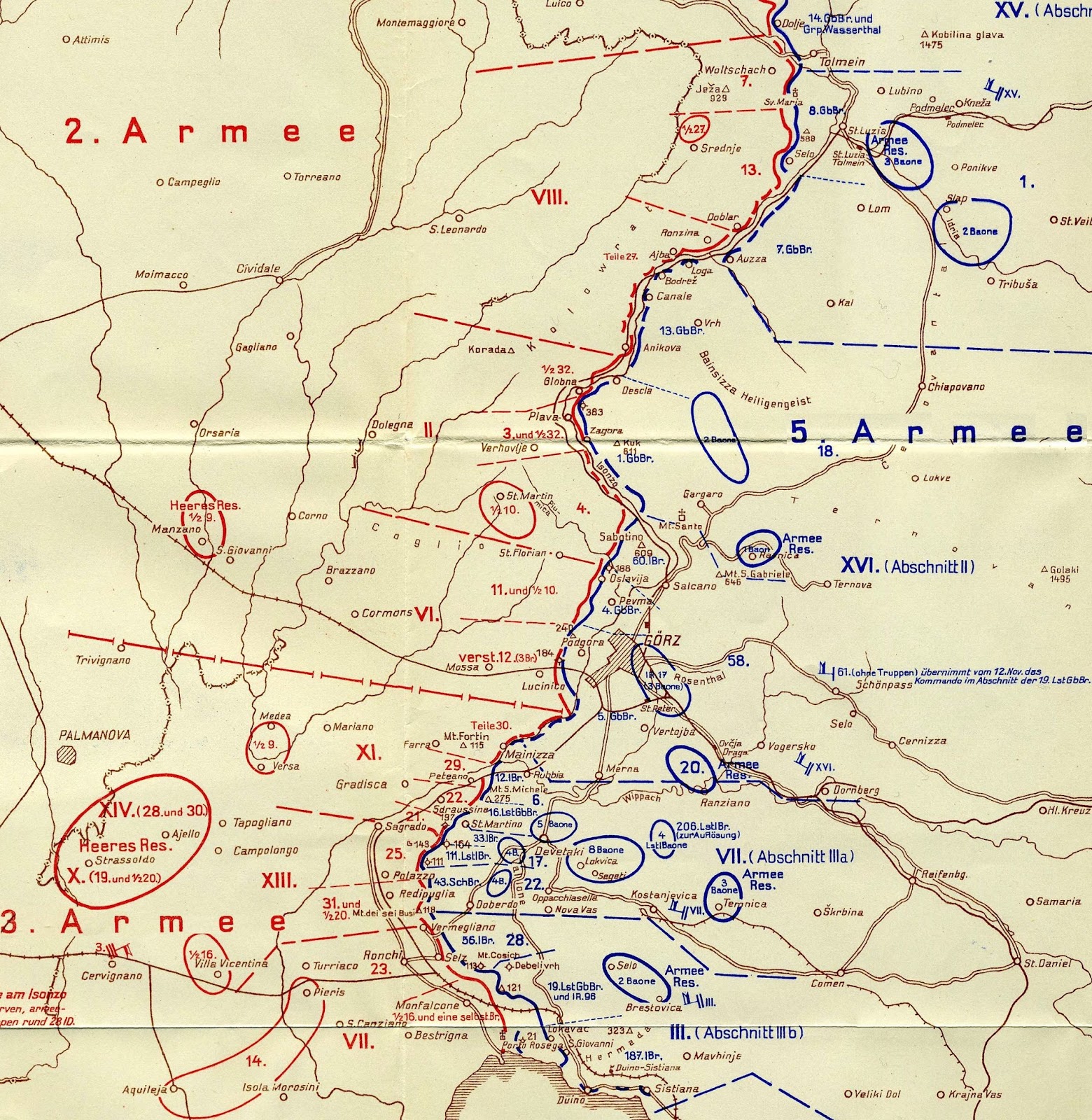 Niedermayer–Hentig Expedition: German ambassador at Teheran sees the precariousness of his position Niedermayer–Hentig Expedition: German ambassador at Teheran sees the precariousness of his positionThe Russian demonstration from Kazvin on the 7th highlighted to the German ambassador at Teheran the precariousness of his position and the Persian government if it can be convinced to side with Germany. With a sense that time is running out, Ambassador Reuss, without reference to Berlin, offers a twenty-year defensive treaty in an effort to win the commitment of the Persians before the Russians can intervene. He also suggests that the Persian government should abandon Teheran, given its proximity to Russian forces to the north, and relocate to Isfahan to the south. Naval operations: Baltic SeaGerman naval tanker SS BURGERMEISTER PETERSEN, 2,893 tons, is sunk by a mine off the Hel (or Hela) Peninsula at Gdynia, Poland. Naval operations: Mediterranean SeaClaus Rücker, commanding U-34, sinks Italian freighter SS BOSNIA, 2,561 tons. This brings his score to 11 ships and 26,548 tons. Naval operations: Gallipoli PeninsulaFreighter SS SAGHALIEN, 4050 tons, is scuttled alongside French battleship MASSENA as part of a breakwater. Photo: MASSENA scuttled as a breakwater off Gallipoli in 1915
|
|
lordroel
Administrator
Member is Online
Posts: 68,054 
Likes: 49,451
|
Post by lordroel on Nov 11, 2020 3:46:54 GMT
Day 470 of the Great War, November 11th 1915Serbian campaign: Mackensen argues that while the original objectives of the Serbian operation have been accomplished, the campaign remains incomplete as long as the Serbian army has not been destroyedWriting to Falkenhayn today, Mackensen argues that while the original objectives of the Serbian operation have been accomplished, the campaign remains incomplete as long as the Serbian army has not been destroyed. This can be best accomplished, in his view, by a vigorous pursuit by the Austro-Hungarian 3rd Army down the Ibar River valley towards Kosovo while the German 11th and Bulgarian 1st Armies advance towards Priština. Here, it is hoped, the Serbian army can be brought to a final battle, made all the more decisive given the historical and cultural significance of the region to Serbian nationalism and identity. Mackensen's hopes are bouyed by intelligence reports today that the Serbian army has lost over half its strength since the beginning of October. Map: The front lines in Serbia, November 11th, 1915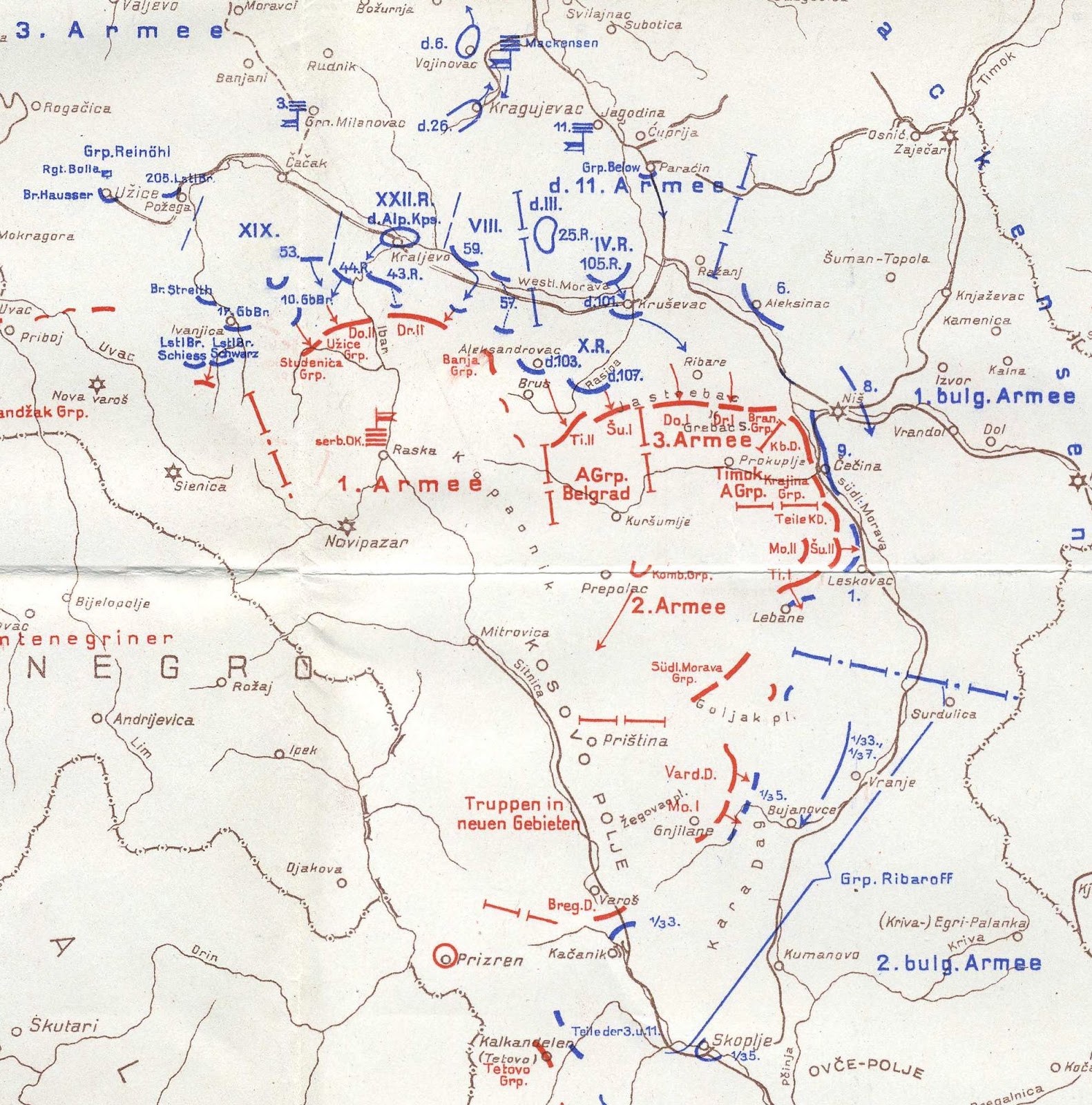 Italian Front: Fourth Battle of the Isonzo Italian Front: Fourth Battle of the IsonzoOn the Italian Front the second day of the latest Italian offensive along the Isonzo River hardly differs from the first. Opposite Görz, the southern wing of the Italian 2nd Army advances between Oslavija and the heights at Podgora, but by the end of the day have only heavy losses to show for their attacks. To the south, the Italian 3rd Army attempts a repeat of the prior day's operations, with a three-hour artillery bombardment preceding infantry assaults at noon. However, a similar effort leads to similar results: most of the attacks break down before even reaching the Austro-Hungarian positions, and in those few cases where the infantry manage to enter the first trench line - mainly near Peteano - counterattacks are able to drive them back out. Mesopotamian campaign: British 6th Indian Division begins its advance towards BaghdadThe British 6th Indian Division begins its advance towards Baghdad today, over two weeks since General Townshend was ordered to capture the city and more than a month since the victory at the First Battle of Kut-al-Amara. The significant delay has been the result of severe supply shortages resulting from the difficulties in bringing sufficient food, fodder, and munitions forward along the Tigris River from the main base at Basra far to the southeast. Even today 6th Indian Division is hardly well-supplied, as soldiers continue to suffer from a range of illnesses related to poor food.
|
|
lordroel
Administrator
Member is Online
Posts: 68,054 
Likes: 49,451
|
Post by lordroel on Nov 12, 2020 3:46:53 GMT
Day 471 of the Great War, November 12th 1915YouTube (Serbia's Last Stand Against The Central Powers)Serbian campaign: French forces have achieved meagre results in the offensive ordered by General SarrailOver the past nine days, French forces have achieved meagre results in the offensive ordered by General Sarrail: elements of the French 57th and 122nd Divisions have crossed the Tcherna River and advanced five kilometres, but are encountering increasingly severe resistance. To the southeast, the French 156th Division at the Strumica rail station has successfully counterattacked Bulgarian forces and driven them back across the border. Nevertheless, Bulgarian forces in the region greatly outnumber the three French divisions Sarrail has available in southern Serbia. Map: The front in southern Serbia after the offensive of Army of the Near East, November 1915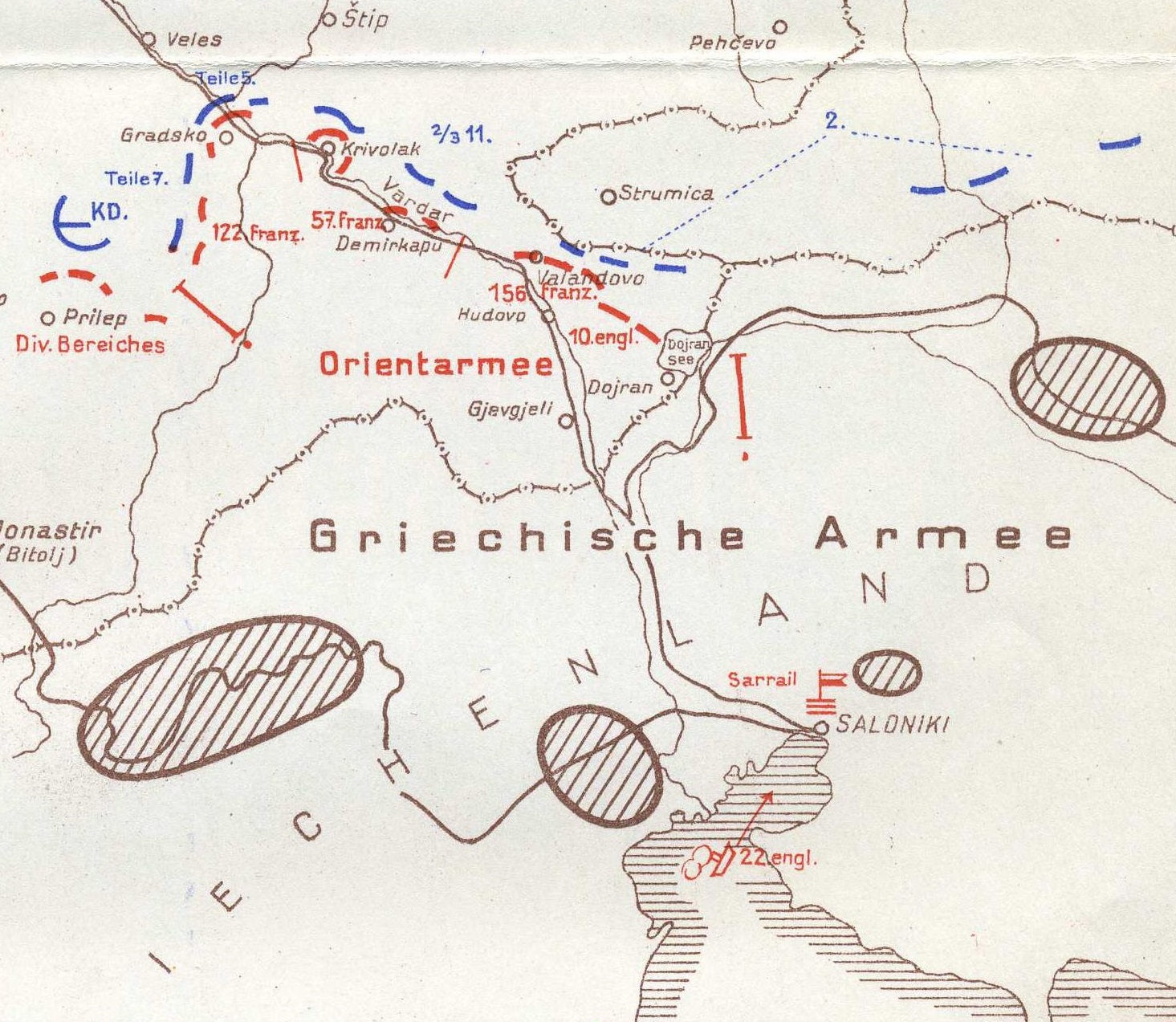 Italian Front: Fourth Battle of the Isonzo Italian Front: Fourth Battle of the IsonzoItalian attacks continue today along the Isonzo River. West of Görz, the morning sees back and forth fighting over a stretch of trench on the west slope of Heights #184 near Podgora, while in the afternoon an Italian assault penetrates the Austro-Hungarian line near the church at Oslavija. To the south, the Italian 3rd Army abandons the broader assaults of the past two days to launch a two-pronged effort to envelop Mt. San Michele, attacking from Peteano to the northwest and near St. Martino to the southwest. Three times Italian infantry advance up the northern slope of Mt. San Michele, and three times they fail to gain any ground. To the south, several regiments attack near Kote, but are repulsed with heavy losses. Persian Campaign: Shah Ahmad of Persia informs Ambassador Reuss that he must secure the approval of the German governmentIn Teheran Shah Ahmad of Persia informs Ambassador Reuss that he must secure the approval of the German government before he will ratify the treaty of alliance offered by the latter. This effectively postpones for several weeks the final decision of the shah on the treaty. Meanwhile, the Russian menace to Teheran increases - an advance Russian detachment is encamped forty miles from the capital, while a larger Russian expeditionary force of eight thousand cavalry and six thousand infantry lands at Enzeli today. Naval operations: French and British anti submarine planRecent sinking by German submarines in the Mediterranean, especially of the transport CALVADOS off Algeria, has sparked concern both in metropolitan France and French North Africa regarding the safety of merchant ships and transports in the Mediterranean. Under pressure, the French minister of marine instructs Vice-Admiral Louis-René-Marie Charles Dartige du Fournet, commander of French naval forces in the Mediterranean, to reach an agreement with the British regarding a general plans for coordinated naval patrols to prevent submarine attacks. Naval operations: English ChannelBritish freighter SS MOORSIDE, 311 tons, bound from Leith to Boulogne, hits a mine laid by Matthias von Schmettow in UC-6. SS Nigel, 1,400 tons, carrying government supplies from Newhaven to Boulogne, also his a mine laid by UC-6. Von Schmettow's score is now 20 ships and 16,197 tons.
|
|



















